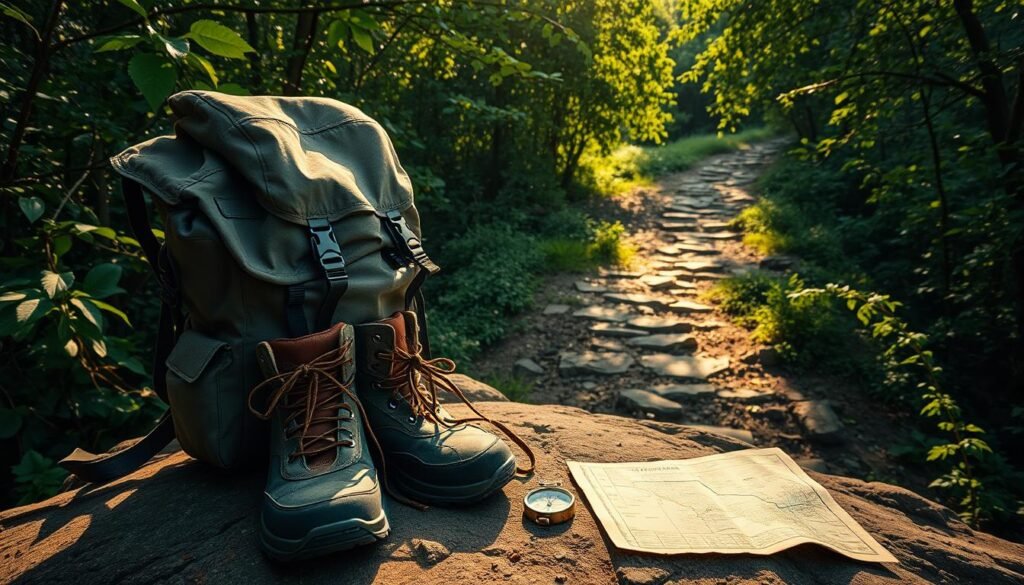Going on an off-grid hiking trip for 3 days was exciting. It pushed me to be ready and determined. I soon saw how important it is to pack the right stuff.
My adventure had both thrilling and regretful parts. I found out that the right outdoor gadget can change a good trip into a great one.
In this article, I’ll talk about my journey. I’ll share what I packed and what I wish I had brought or left behind. This will help other outdoor lovers.
Key Takeaways
- Packing the right gear is crucial for a successful off-grid hiking experience.
- A reliable outdoor gadget can be a lifesaver in challenging situations.
- It’s essential to strike a balance between preparedness and minimalism.
- Learning from others’ experiences can help you prepare better.
- Off-grid hiking requires a combination of physical endurance and mental toughness.
My Off-Grid Adventure: Planning for 3 Days in the Wilderness
Going on an off-grid hiking adventure needs careful planning. It’s important to think about safety and fun before you go into the wild.
Choosing the Trail and Setting Expectations
Picking the right trail is key for a great off-grid hike. Look at the terrain, how far it is, and any dangers. It’s also important to know your limits and what challenges you might face.
Doing research on the trail helps you get ready. Knowing how hard it is will help you prepare better.
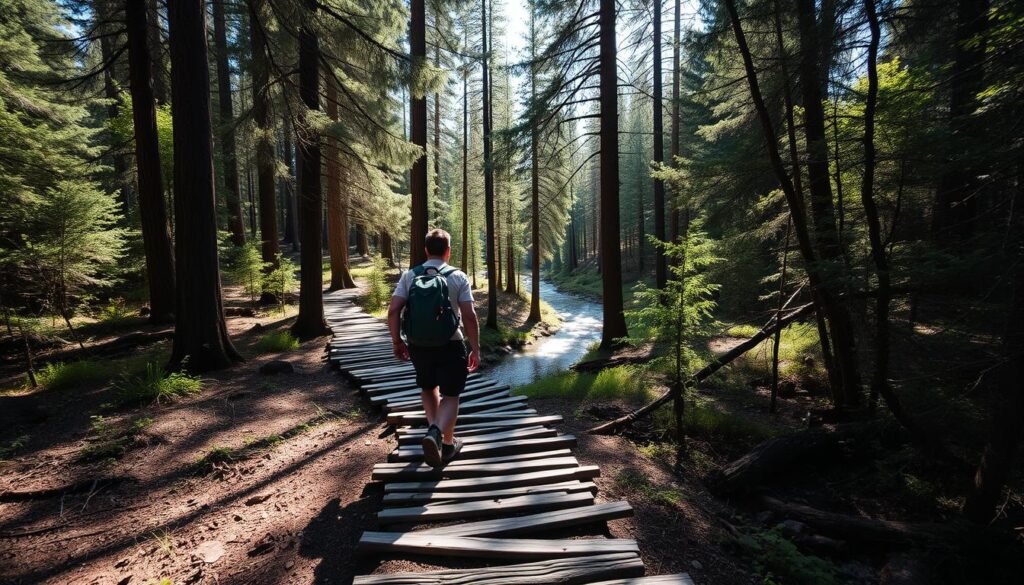
Weather Considerations and Timing
The weather can really change your hiking trip. Always check the forecast and be ready for sudden changes. The time of year you go also matters. Pick a time when the weather is better.
Being ready for surprises is part of Grid Hiking. Having a must-have travel gadget like a portable weather radio is very helpful.
What is Grid Hiking? The Reality of Going Off the Grid
Grid hiking is all about being alone in nature. It’s a real test of how well you can rely on yourself. You’ll face the wild with just your brain and what you’ve packed.
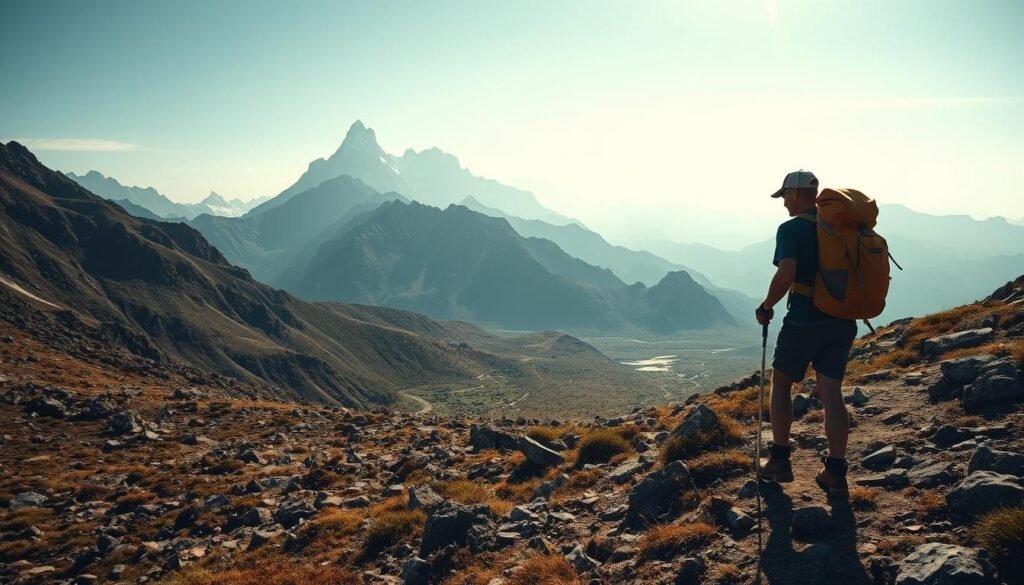
No Connectivity, No Facilities
Grid hiking means no phone signal and few places to find help. This means:
- No emergency calls or texts
- No access to real-time weather updates
- No convenience stores or restaurants
You have to carry everything. This includes food, water, first aid, and maps.
Mental and Physical Preparation
Grid hiking needs strong mental toughness and physical endurance. To succeed, you must:
- Train physically to handle the demands of hiking with a heavy pack
- Prepare mentally by understanding the risks and challenges involved
- Develop a positive mindset to overcome obstacles
Being well-prepared lets you enjoy nature’s beauty. You’ll also feel proud of what you’ve achieved.
My Complete Packing List Overview
Starting my off-grid hiking adventure needed careful planning. I made a detailed packing list. Grid hiking requires choosing what to carry wisely, as it affects your trail experience.
For my 3-day off-grid hiking trip, I aimed for the right balance. I packed top-rated outdoor gadgets that were crucial on my journey.
Weight Distribution Breakdown
Even weight distribution is key in grid hiking. I sorted my gear into must-haves like shelter, food, and navigation tools. Then, I spread these out in my backpack.
I organized my backpack with the heaviest items, like water and food, near my back. This kept me balanced and less tired.
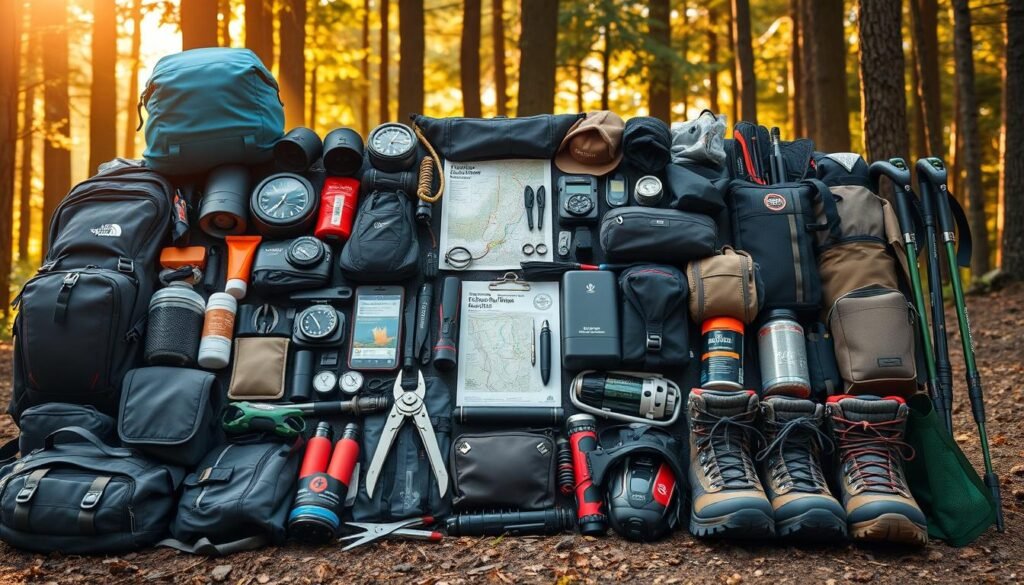
Organization System
Having a good organization system is essential for grid hiking. I used packing cubes and stuff sacks to keep things sorted and easy to find.
This method let me quickly find what I needed without unpacking everything. It saved time and reduced stress during the trip.
With a well-planned packing list and organized gear, my off-grid hiking trip was smoother and more enjoyable.
Essential Gear That Saved My Trip
When you head into the wilderness, the right gear is a must. During my off-grid hike, some items were key to my safety and comfort.
Navigation Tools That Proved Invaluable
Navigation is crucial in off-grid hiking. Without the right tools, getting lost is easy.
Maps and Compass Setup
I used a detailed topographic map and a reliable compass. Before I left, I set up my map and compass correctly. I also made sure my compass was calibrated.
GPS Backup Solution
I also had a GPS device as a backup. It helped me track my route and find my way back. I carried extra batteries to keep it working all trip long.
| Navigation Tool | Description | Importance Level |
|---|---|---|
| Map | Detailed topographic map | High |
| Compass | Reliable compass with declination adjustment | High |
| GPS Device | GPS device with extra batteries | Medium |
Power Solutions for Critical Devices
Keeping my devices charged was key, like my GPS and phone.
I used a portable power bank to charge on the go. It was a lifesaver when sunlight was low.
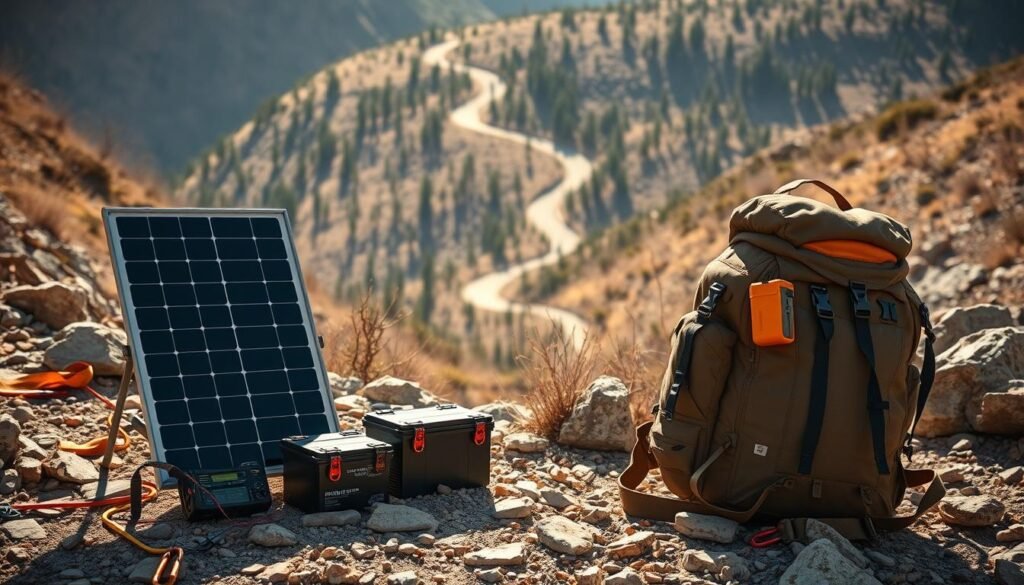
With these tools, I safely navigated the wilderness and stayed connected when needed.
The Shelter Setup: What Worked in Changing Weather
My off-grid hiking adventure showed me how important a good shelter is. I chose a shelter that would protect me from the weather. This was crucial for my three-day grid hiking trip.
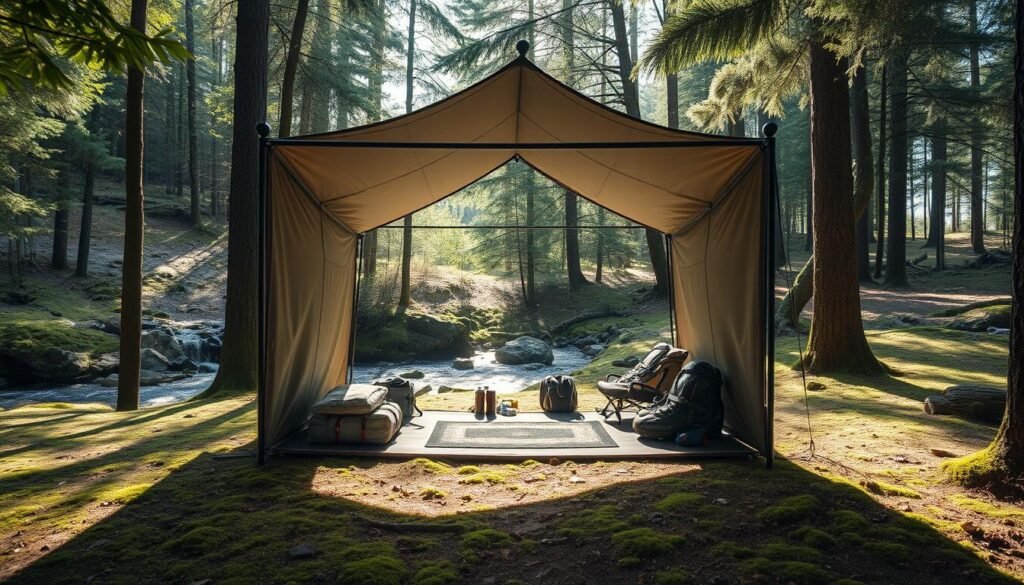
My Tent Choice and Performance
Choosing the right tent was a big decision. I picked a lightweight, waterproof tent that could handle wind and rain. The REI Co-op Half Dome 2 Plus was a great choice. It was spacious and durable, keeping me dry and comfy.
Sleep System Components
Getting a good night’s sleep is key for off-grid hiking. The right sleep system is essential. It includes a sleeping pad and a sleeping bag, each with its own role.
Sleeping Pad Selection
I went with the Therm-a-Rest NeoAir XLite sleeping pad. It’s light and keeps you warm, even when it’s cold.
Sleeping Bag Temperature Rating
My sleeping bag was rated for 30°F (-1°C). It was perfect for the cold nights. Picking a sleeping bag with the right temperature rating is crucial for a good night’s sleep.
As
“A good shelter and sleep system are the cornerstones of a successful off-grid hiking experience.”
This was my motto for the trip. And it was spot on.
Food and Water Strategy for 3 Days
During my 3-day grid hiking adventure, I learned the importance of a good food and water plan. Managing these resources well is key to keeping energy up and staying healthy while hiking off-grid.
Water Filtration and Storage
Having clean drinking water is essential. I used a portable water filter, a gadget that became one of my essentials, to make water from streams and lakes safe to drink. This saved me from carrying too much water and made sure I stayed hydrated.
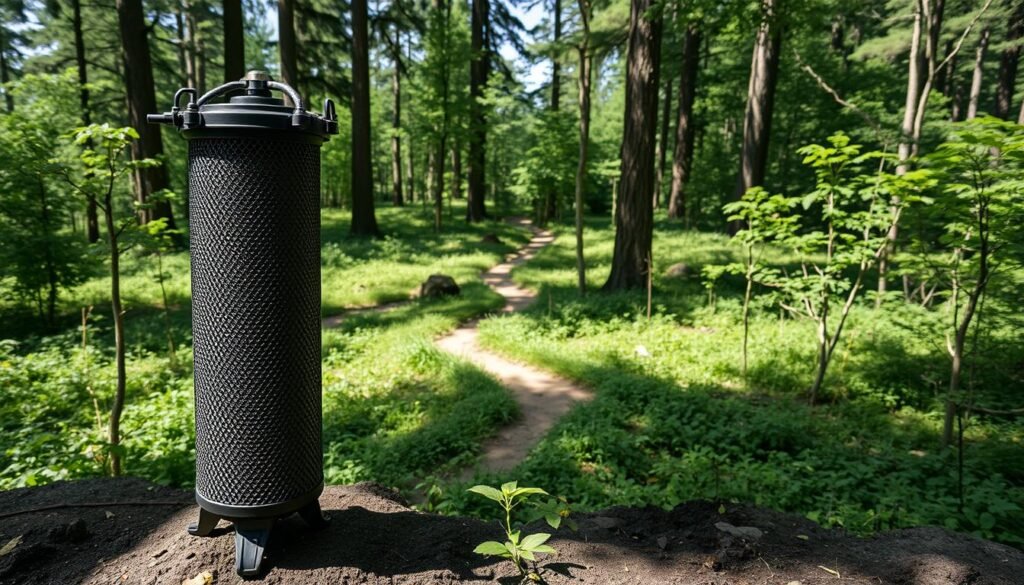
Meal Planning and Execution
Planning meals ahead is crucial for grid hiking. I chose lightweight, high-calorie foods that were simple to make. My meals included dried fruits, nuts, jerky, and MREs (Meals Ready to Eat).
Breakfast, Lunch, and Dinner Approach
For breakfast, I had oatmeal with dried fruits. Lunch was jerky and nuts, and dinner was MREs or dehydrated meals that only needed boiling water. This plan gave me a balanced diet and was easy to manage in the wild.
Snacks and Emergency Rations
I also carried snacks like energy bars and trail mix. I had extra MREs as emergency rations in case of unexpected delays.
With a solid food and water plan, I enjoyed my grid hiking trip without worrying about hunger or dehydration. It made the adventure much more fun.
Clothing Choices: The Layering System That Worked
Off-grid hiking requires careful clothing choices. I learned that layering is key. It helps hikers adjust to weather changes, keeping them comfortable and safe.
Base Layers and Insulation
Base layers are the first step in layering. I chose moisture-wicking fabrics for dry comfort. For cold, I added fleece and down layers for warmth without weight.
Choosing the right base layers and insulation is vital. A good base layer controls body temperature. Insulation keeps you warm in cold.
| Layer | Material | Function |
|---|---|---|
| Base Layer | Moisture-wicking fabric | Regulates body temperature |
| Insulating Layer | Fleece, Down | Provides warmth |
Rain Gear and Footwear Decisions
Rain gear is crucial for off-grid hiking. I used a waterproof jacket and pants for dryness and breathability. Sturdy, waterproof hiking boots were essential for support and traction.
A good pair of hiking boots is a hiker’s best friend. They offer comfort and protection against rough terrain and wet conditions. When picking rain gear and footwear, think about function and durability.
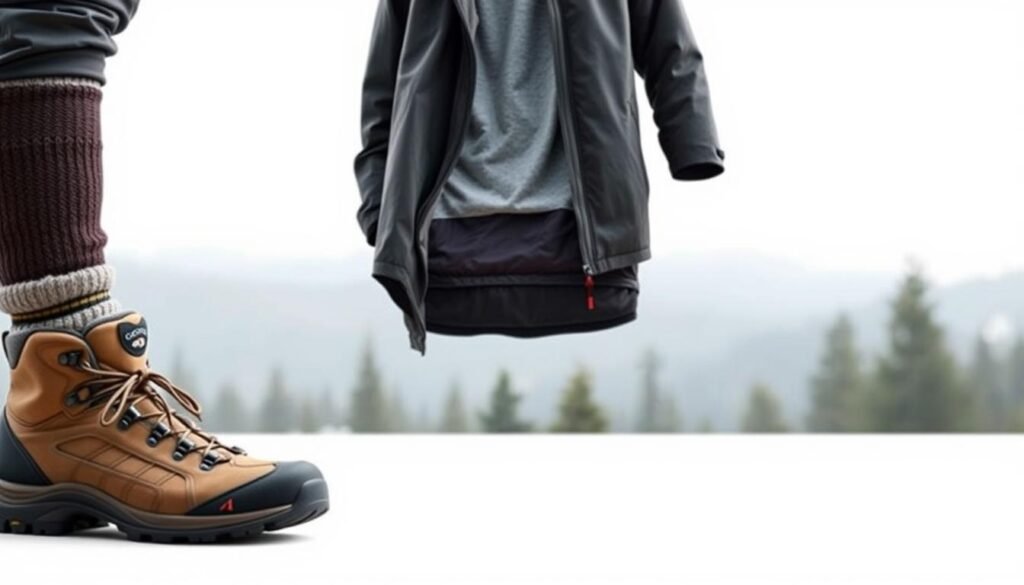
Safety Equipment: The Non-Negotiables
When you head into the wilderness, safety gear is a must. Off-grid hiking comes with risks, from small injuries to serious dangers. Having the right safety equipment can be a game-changer.
First Aid Kit Components
A good first aid kit is key for safety. It should have bandages, antiseptic wipes, pain relievers, and any personal meds. Also, remember to include blister care and insect bite treatments.
| Item | Description | Quantity |
|---|---|---|
| Bandages | Assorted sizes for cuts and scrapes | 10 |
| Antiseptic Wipes | For cleaning wounds | 20 |
| Pain Relievers | For headaches and minor aches | 5 |
Emergency Communication Options
In emergencies, having a way to call for help is crucial. Carry a satellite phone or a personal locator beacon (PLB). These can save lives in places with no cell service.
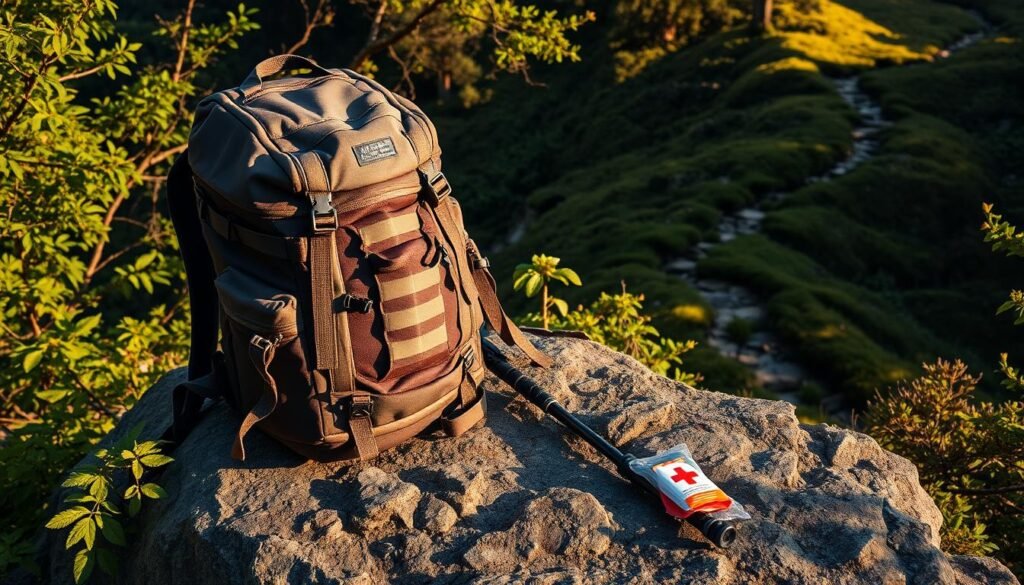
A satellite phone lets you talk to others, while a PLB sends a distress signal. Both are outdoor travel essentials for serious off-grid hikers.
My Biggest Packing Regrets
My three-day off-grid hiking trip taught me a lot about packing. I learned what to bring and what to leave out. Looking back, I see some items I didn’t need and others I wish I had skipped.
Unnecessary Weight I Carried
I made a big mistake by carrying too much stuff. Some items were too big and heavy. They took up space in my backpack.
Redundant Items
I packed too many socks, thinking it was smart. But, as Mark Twain said, “The secret of getting ahead is getting started.” Starting with less would have been better. I also had too many batteries and a duplicate water filter, adding to the weight.
Oversized Equipment
My big camping stove was a regret. It was too big and heavy. A smaller, lighter stove would have been better.
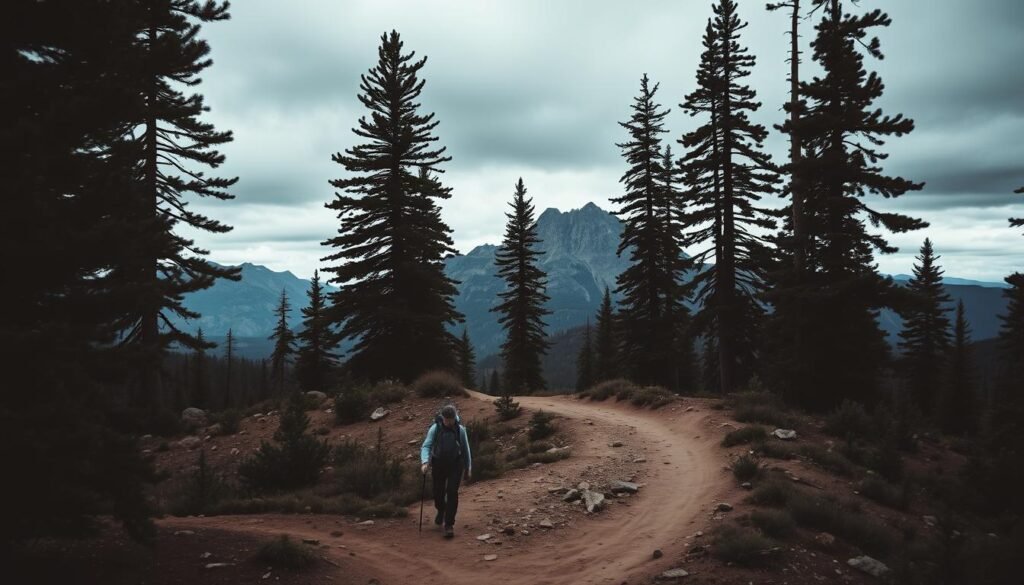
Items I Wish I’d Left Behind
There were things I wish I hadn’t brought. Like a book, thinking I’d read a lot. But, I was too tired to read. I also packed too much clothes, wearing the same things over and over.
As
“The best way to get started is to quit talking and begin doing.”
– this quote by
really hit home. It shows that sometimes, less is better, like in Grid Hiking.
What I Wish I Had Brought: The Missing Essentials
My off-grid hiking trip was amazing, but looking back, I wish I had brought more. I was well-prepared with the basics, but some extra items would have made it even better.
Comfort Items Worth Their Weight
Comfort items can really make a trip more enjoyable. I wish I had packed a portable hammock, a camp chair, or even a favorite snack. These small luxuries can lift your mood and add relaxation to the wilderness.
- A portable hammock for resting
- A lightweight camp chair for comfort
- Favorite snacks for a morale boost
Tools That Would Have Made a Difference
There were also tools that would have helped a lot. A portable water purifier, for example, would have been great. So would a multi-tool or a repair kit for my gear. These tools could have eased some of the hiking challenges.
- A portable water purifier for safe drinking water
- A multi-tool for various tasks
- A repair kit for gear maintenance
The One Outdoor Gadget I Never Travel Without Anymore
After my off-grid hiking experience, I realized one gadget is key to my outdoor adventures. During my three-day trek, I used many tools. But one stood out for its versatility and reliability.
The gadget that has become my trusted companion is a portable power bank. It charges my devices on the go. This has been a lifesaver, even in unfamiliar territories.
Why This Became My Must-Have Travel Companion
This power bank is now my must-have travel companion. Its compact design and high capacity are perfect. It lets me stay connected with family and emergency services while keeping my navigation tools working.
The peace of mind it gives is priceless. I know I can recharge my devices whenever I need to.
How to Choose the Right Version for Your Needs
When picking a portable power bank, think about your device’s power needs and the bank’s capacity. Choose a model with a high milliampere-hour (mAh) rating. This ensures it can charge your devices multiple times.
Also, consider the power bank’s durability and weather resistance. It should handle the challenges of off-grid hiking well.
Conclusion: Is Off-Grid Hiking Worth It?
After three days off the grid, hiking in the wilderness, I realized something important. Off-grid hiking is truly transformative. It tests your limits, pushing you physically and mentally.
It taught me about preparation, the right gear, and being flexible. This journey showed me the value of simplicity. By removing modern distractions, I connected with nature and myself.
The trip’s challenges, like navigating new areas and unpredictable weather, were overcome. The right tools and creativity helped a lot.
So, is off-grid hiking worth it? The answer is yes, for personal growth, the thrill of discovery, and the beauty of untouched landscapes. If you want to escape the daily rush and reconnect with nature, off-grid hiking is definitely worth trying.

